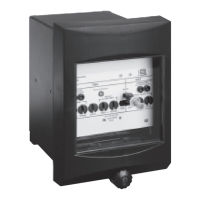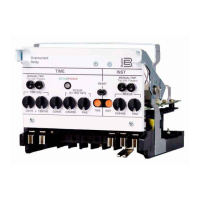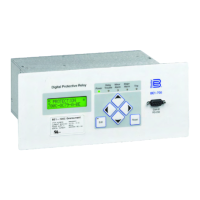BE1-50/51B
CURRENT INPUT
A single phase of ac current from a 5 Amp, or 1 Amp,
50/60 Hz, system current transformer (CT) is applied to
the BE1-50/51B. This input current provides both the
power and sensing quantity for the relay.
The current applied to the relay provides the energy for
the internal power supply. When sufficient current is
available, the Active/Pickup LED will turn green. In appli-
cations where circuit loading conditions are less than
that required to illuminate the LED, the relay remains
operable and will provide overcurrent protection.
The sensing input transformer provides the quantity to
be scaled and measured by the Time and Instantaneous
functions. Ranges, ratings, and accuracies apply as
described in Table 1.
FEATURES
• 15 field selectable, inverse, fixed time and British
Standard (BS142) time overcurrent curves on 200
series relays (10 on 100 series).
• Time characteristics extend to 40 X Pickup.
• Instantaneous overcurrent function.
• Wide setting ranges:
Time Overcurrent: 0.5 to 15.9 (5 Amp Unit)
0.1 to 3.18 (1 Amp Unit)
Inst. Overcurrent: 2.0 to 99 (5 Amp Unit)
0.2 to 19.8 (1 Amp Unit)
• Current pickup accuracy ± 2%.
• Timing accuracy ± 2%.
• Continuous automatic calibration.
• Less than 10% transient overreach.
• Zero Pickup setting for safety during installation.
• Timed Overcurrent Reset - Selectable Instantaneous
or Decay Characteristic (200 series relays only).
• 5VA burden (at nominal) self powered from 50/60 Hz
systems, utilizes standard 5 or 1 Amp CT secondaries.
• Drawout construction.
• Manual method for trip circuit testing.
• Standard magnetically latched targets for TOC
and IOC.
• Direct reading front panel controls.
• Positive visual indication that microprocessor is
executing code.
• UL recognized under standard 508.
• Qualified to the requirements of:
-IEEE C37.90.1-1989 for SWC.
-IEEE C37.90.2-1989 for RFI.
-IEC 255-5 for impulse.
APPLICATION
The BE1-50/51B is a single phase self powered, micro-
processor based time overcurrent relay. The relay is
designed for use in applications requiring time delayed
coordination for phase or ground overcurrent condi-
tions.
The relay can be used to provide coordinated protection
for overhead and underground distribution circuits. Other
applications include overcurrent back-up protection for
transformers and generators, the protection of neutral
grounding resistors and reactors, and motors.
Since all of the time-current characteristics are included
within the relay, a standard relay may be ordered before
the coordination study is completed, thereby allowing
the physical construction to proceed. 100 series relays
have curves that match ABB/Westinghouse time curve
shape. 200 series adds five unique GE-type curves. See
Table 2 for available curve types. This is also an advantage
as changes in the system configuration or coordination
may be accomplished without a hardware change.
Models are included (200 series) which have memory to
replicate the decaying reset of electromechanical relays
even when power to the relay is lost. Use the 200 series
for applications that require coordination with the reset-
ting of nearby electromechanical relays.
The instantaneous overcurrent element is standard in the
relay. This element is designed to minimize transient
overreach. The instantaneous element includes select-
able delay characteristics for improved coordination with
downstream devices and customer requirements.
2
FUNCTIONAL DESCRIPTION
Scaling of the input signal is accomplished by separate
networks for the time and instantaneous functions. The
scale factors are established by the front panel pick-up
settings. Pickup settings of 00 provide maximum
sensitivity as a safety precaution for the installation
process. Pickup will occur when the input current level is
adequate to power the unit.
MICROPROCESSOR
The setting of the TIME DIAL, TIME CURVE selector switch,
and circuit board jumpers provide the micro-processor
with ten operating parameters for the desired response by
the relay. The microprocessor performs the program
operations based on the input current level and internal
software program. When the Active/Pickup LED is green,
the microprocessor is active and executing code.

